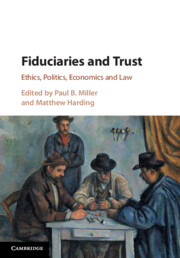78 results
A New Radiocarbon Database for the Lower 48 States
-
- Journal:
- American Antiquity / Volume 87 / Issue 3 / July 2022
- Published online by Cambridge University Press:
- 07 February 2022, pp. 581-590
- Print publication:
- July 2022
-
- Article
-
- You have access
- Open access
- HTML
- Export citation
KEEPING JUSTICE (LARGELY) OUT OF CHARITY: PLURALISM AND THE DIVISION OF LABOR BETWEEN CHARITABLE ORGANIZATIONS AND THE STATE
-
- Journal:
- Legal Theory / Volume 26 / Issue 4 / December 2020
- Published online by Cambridge University Press:
- 26 January 2021, pp. 281-304
- Print publication:
- December 2020
-
- Article
- Export citation
Part I - Personal Trust and Fiduciary Relationships
-
- Book:
- Fiduciaries and Trust
- Published online:
- 13 March 2020
- Print publication:
- 02 April 2020, pp 15-102
-
- Chapter
- Export citation
Part IV - Trust and Fiduciary Law in Context
-
- Book:
- Fiduciaries and Trust
- Published online:
- 13 March 2020
- Print publication:
- 02 April 2020, pp 273-331
-
- Chapter
- Export citation
Part II - Personal Trust and Fiduciary Duties
-
- Book:
- Fiduciaries and Trust
- Published online:
- 13 March 2020
- Print publication:
- 02 April 2020, pp 103-172
-
- Chapter
- Export citation
Contents
-
- Book:
- Fiduciaries and Trust
- Published online:
- 13 March 2020
- Print publication:
- 02 April 2020, pp vii-viii
-
- Chapter
- Export citation
Introduction
-
-
- Book:
- Fiduciaries and Trust
- Published online:
- 13 March 2020
- Print publication:
- 02 April 2020, pp 1-14
-
- Chapter
- Export citation
Acknowledgements
-
- Book:
- Fiduciaries and Trust
- Published online:
- 13 March 2020
- Print publication:
- 02 April 2020, pp xi-xii
-
- Chapter
- Export citation
Copyright page
-
- Book:
- Fiduciaries and Trust
- Published online:
- 13 March 2020
- Print publication:
- 02 April 2020, pp iv-iv
-
- Chapter
- Export citation
3 - Contracts, Fiduciary Relationships and Trust
- from Part I - Personal Trust and Fiduciary Relationships
-
-
- Book:
- Fiduciaries and Trust
- Published online:
- 13 March 2020
- Print publication:
- 02 April 2020, pp 55-73
-
- Chapter
- Export citation
Dedication
-
- Book:
- Fiduciaries and Trust
- Published online:
- 13 March 2020
- Print publication:
- 02 April 2020, pp v-vi
-
- Chapter
- Export citation
Part III - Political Trust and Fiduciary Government
-
- Book:
- Fiduciaries and Trust
- Published online:
- 13 March 2020
- Print publication:
- 02 April 2020, pp 173-272
-
- Chapter
- Export citation
Index
-
- Book:
- Fiduciaries and Trust
- Published online:
- 13 March 2020
- Print publication:
- 02 April 2020, pp 332-344
-
- Chapter
- Export citation
Contributors
-
- Book:
- Fiduciaries and Trust
- Published online:
- 13 March 2020
- Print publication:
- 02 April 2020, pp ix-x
-
- Chapter
- Export citation

Fiduciaries and Trust
- Ethics, Politics, Economics and Law
-
- Published online:
- 13 March 2020
- Print publication:
- 02 April 2020
16 - An Argument for Limited Fission
- from Part III - Functional, Analytical and Theoretical Views
-
-
- Book:
- Equity and Law
- Published online:
- 26 July 2019
- Print publication:
- 01 August 2019, pp 374-393
-
- Chapter
- Export citation
Mindfulness for Psychosis Groups; Within-Session Effects on Stress and Symptom-Related Distress in Routine Community Care
-
- Journal:
- Behavioural and Cognitive Psychotherapy / Volume 47 / Issue 4 / July 2019
- Published online by Cambridge University Press:
- 18 January 2019, pp. 421-430
- Print publication:
- July 2019
-
- Article
- Export citation
MSP Binaries as Astrophysical Laboratories
-
- Journal:
- Proceedings of the International Astronomical Union / Volume 13 / Issue S337 / September 2017
- Published online by Cambridge University Press:
- 04 June 2018, pp. 420-421
- Print publication:
- September 2017
-
- Article
-
- You have access
- Export citation
Hard Spectral Tails in Magnetars
-
- Journal:
- Proceedings of the International Astronomical Union / Volume 13 / Issue S337 / September 2017
- Published online by Cambridge University Press:
- 04 June 2018, pp. 108-111
- Print publication:
- September 2017
-
- Article
-
- You have access
- Export citation
1 - Charity law in overview
-
- Book:
- Charity Law and the Liberal State
- Published online:
- 05 October 2014
- Print publication:
- 09 October 2014, pp 6-42
-
- Chapter
- Export citation



